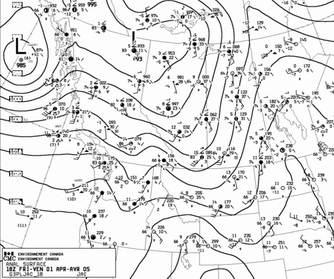
Some suggestions/reminders/tips for the weather briefings
Your team weather briefing to class will constitute 10% of your course mark. You will have up to 20 minutes to present. You need not necessarily focus on Edmonton's or Alberta's or Western Canada's weather, if there is another locale of more interest to you or where something interesting is happening. Your presentation may mix retrospective, analysis and prognosis (whatever best suits the story you want to tell). As the 00Z GEM runs may not be available until something like 10 pm MDT, you may use progs based on the 18Z initialization if you wish.
Axes considered for the scoring:
- Diligence
- Clarity, and appropriate selection of, visuals
- Effectiveness of presentation (pace, timing, projection...)
- Structuring of the briefing (may be helpful to formulate and defend a specific proposition or hypothesis)
- Correctness (depth and validity of meteorological interpretations)
To project the maps and charts for your briefing you may:
- bring your own laptop, or
- access (your own) web page, or
- bring a USB key
A few pointers:
- Remember that weather analyses are not archived in a way that is accessible to the public. Thus when preparing a briefing you must anticipate what period of time you need maps and charts for, and be sure to dowload them on your own time
- Do your best to optimize the way you show any given chart. This may entail cropping. If you right click on an image in PowerPoint, the Picture Toolbar will allow you to move the edges of a image, reducing it to the area you want. You can also adjust resolution to reduce the size of your file, if necessary.
- On every analysis or prog you show, be sure that the date, time, and atmospheric level are prominently visible
- Avoid too quickly flipping images to and from the audience's attention. Each image should be visible for a sufficient length of time (perhaps no less than one minute, and possibly as long as 2-3 minutes), while you make the points that justify your having chosen to show that particular map/chart (an animation is an obvious exception to this principle)
- Practise your briefing, as a team, in advance. Know what your respective roles are. Know in advance your timing will be about right (aim for 15-20 minutes, allowing a couple of minutes for likely questions).
- If you think it would help your audience to follow, you could hand out a hard copy of any particularly important chart
- In your introduction, state the structure of your presentation: that is, foreshadow what you plan to cover. This is where it is helpful if you have a hypothesis to state.
- Know what your story is. Lay it out methodically. Don't assume anything is too obvious to be stated - the audience has not been prepared the way you, the speakers, have prepared yourselves. Every point must be made explicitly. It is a good practise to keep reminding the audience why you are making any given point, in relation to your overall theme/goal/hypothesis. This will keep you on track.
- Speak clearly and definitely. Your manner or style of presentation is almost as important as your content. If you feel and project conviction, you can convey this to the audience. To do this, you must have felt interested yourself by the features/relationships/hypotheses/guesses you are conveying - and this has to have entailed developing your own conviction.
Back to the EAS372 home page.
Last Modified: 3 Jan., 2017
